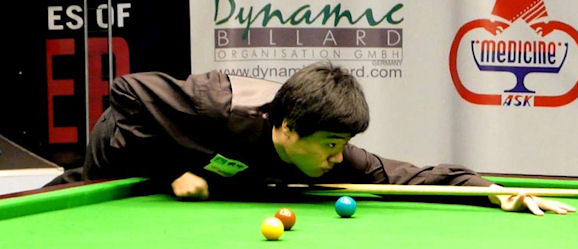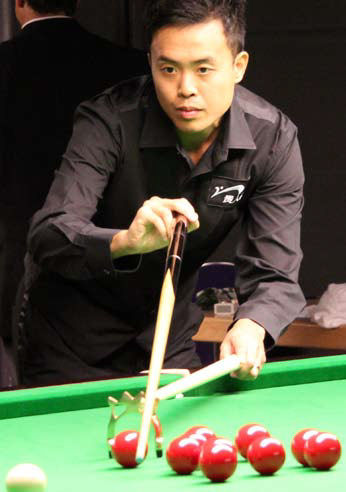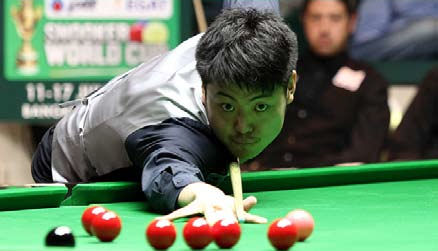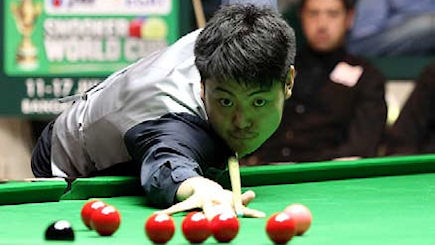This article first appeared in the Mar/Apr 2014 issue of World Gaming magazine.
Following our article about the China Open Snooker in WGM issue #15, many of our readers contacted us wanting to know more about this fascinating sport. The British are still the dominant force in snooker, but China has much up-and-coming young talent and is destined to become a major power. This emerging Chinese talent base is quickly dispelling the misconception of snooker being a game only played by rich Europeans sipping on cognac and puffing on cigars.
“Cue sports” is a term used to describe a family of games. All cue sports involve hitting a white ball (the “cue ball”) with the end of a long stick (known as a “cue”) along a baize-covered rectangular table, with the aim of making that cue ball hit another ball (known as the “object ball”). Usually the goal is to make the object ball fall into one of six “pockets”. There is a pocket in each corner of the table and one in the centre of each of the table’s longest sides. This is known as “sinking”, “potting” or “pocketing” the object ball. Sometimes the goal is not to pot the object ball, but to move it and/or the cue ball to certain positions on the table.

Chinese champion Ding Junhui
There are numerous different cue sports. Many are familiar with pool, eight-ball and nine-ball, popularized by the Americans. Played on relatively small tables, they are fast games which are simple to learn. These games have seen cue sports grow, especially as bar activities played while enjoying a drink. The Philippines has a rich tradition in these “small table” cue sports.
Both billiards and snooker are played on very large tables (officially 12 feet by 6 feet) and are generally restricted to snooker halls, gentlemen’s clubs and the houses of the very well to do. For some strange reason the name “billiards” is used both as a general term for all cue sports, and also to refer more specifically to one particular variation played with just three balls: two white and one red. This particular game is complicated and focuses on controlling the position of the balls, rather than sinking them in the pockets. This three-ball version of billiards is no longer popular and snooker has replaced it as the pre-eminent cue sport.
A highly strategic game requiring advanced thinking coupled with physical skill and dexterity, snooker is generally regarded to have been invented by the British armed forces stationed in India in the second half of the 19th century.
Considered by many as the Rolls Royce of cue sports, snooker is played with a cue ball and 21 other balls: 15 red (all worth one point), one yellow (two points), one green (three points), one brown (four points), one blue (five points), one pink (six points) and one black (seven points). The yellow, green, brown, blue, pink and black balls are collectively known as the “colors”, with the red balls simply known as “reds”.
Snooker Points System

The aim of the game is to pot the reds and colors and thus score points. Players must alternate between potting a red ball and a color. After a red has been sunk, the player may choose to sink any of the colors, before again sinking a red ball. As long as at least one red ball remains on the table, when colors are sunk they are immediately brought back out onto the table, being placed on a fixed spot for each different color. This alternating between reds and colors continues until a ball is not sunk, at which time play moves to the other player. The total score made in any one particular visit to the table by a player is known as the score for that “break”.
Once the 15 red balls have all been sunk, the colored balls need to be pocketed in order from lowest value to highest: yellow, green, brown, blue, pink and finally the black. At this stage of the game, the colors remain in the pockets when sunk. The winner is the player who has tallied the most points after the black ball has been pocketed for the final time, leaving just the cue ball alone on the tabletop.
Points may also be acquired by a player’s opponent committing a foul, which occurs when a mistake is made, either accidently or purposefully. Mistakes include:
- the cue ball failing to hit any other ball
- potting the cue ball
- hitting a color when a red should be hit
- hitting a red when a color should be hit
- playing a shot with both feet off the ground
- potting a ball out of sequence
Fouls are a minimum of four points, but will be five, six or seven points respectively if the foul involves the cue ball mistakenly hitting the blue, pink or black. If a color is potted as a result of a foul shot, it is returned to the table, but mistakenly potted reds stay off the table. After committing a foul, the offending player leaves the table and his opponent begins his next break.

Hong Kong’s Marco Fu
It takes countless hours of practice to become even moderately skilled at snooker. The game requires excellent hand-eye coordination and an ability to control the final position of the cue ball after each shot, often through applying spin to it. Sometimes the game calls for finesse, other times for power. A thorough understanding of angles is essential and even trigonometry can be helpful. As well as requiring the ability to pot many balls in a row, a good player must know when he can’t pot a ball. On such shots he will aim to leave his opponent in an awkward position, thus reducing the chance of his opponent potting, and increase the chance of his opponent committing a foul.
Any explanation of the game of snooker would be incomplete without mentioning the magical “maximum”, also known as a 147. This number represents the highest score a player can accrue in a single break. This is a rare and special feat, somewhat akin to the elusive “nine-darter” in the game of darts. A 147 can only be scored if a player pots all 15 reds, each time followed by the highest scoring color, the black, followed by all six colors, in a single break. This requires 36 shots in a row without missing a pot. No mean feat! It is widely acknowledged amongst sports analysts that shooting a 147 is substantially more difficult than hitting a hole-in-one in golf. Whenever the final black ball of a 147 is sunk, the assembled crowd roars into thunderous applause.
There is a special rule that allows the possibility of breaks up to 155 but the circumstances surrounding this rule occur so incredibly rarely that a score of over 147 occurred for the first time ever in a professional match in 2004, well over 100 years after the invention of the game. It is reasonable to think of 147 as being the maximum that can be scored in any single break. A total of 89 official 147s have been achieved in professional competition, with England’s Ronnie O’Sullivan and Scotland’s Stephen Hendry holding the record, both having completed the feat on no less than 11 occasions.

China’s left handed ace, Liang Wenbo
Although still dominated by players from Great Britain, there are some incredible Chinese snooker players. Chinese champion Ding Junhui shocked the world by winning the China Snooker Open back in 2005 as a wildcard entry. Ding, dubbed “the star of the East”, won the 2011 Masters snooker tournament, defeating Hong Kong countryman Marco Fu in an all-Chinese final, and in the same year reached the semi-final of the World Snooker Championship. He has compiled more than 200 competitive century breaks (a break of 100 points or more), and shot five 147 maximum breaks on the professional stage. Ding was ranked 10th on the list of top earning Chinese athletes for 2011, having earned US$1.19 million. In February 2012 he took down the Welsh Open, worth £30,000 , then continued his good form in March 2012 with a victory in the invitation only Championship League. Ding won the 2013 Shanghai Masters by beating Xiao Guodong in an all-Chinese final.
China’s Liang Wenbo and Xiao Guodong continue to battle it out for China’s number two spot, and Marco Fu from Hong Kong is best known for winning the 2007 Grand Prix snooker tournament in Aberdeen, Scotland, beating the great Ronnie O’Sullivan in the process.
Support for snooker in China has been steadily growing in recent years. Up and coming Chinese snooker players to look out for include Liu Chuang, Liu Song, and Li Yan. Don’t be surprised if we see a Chinese world number one before the decade is out.







